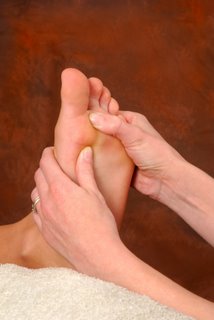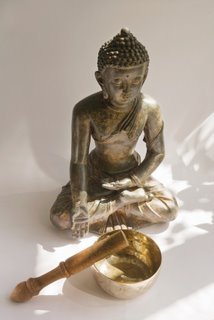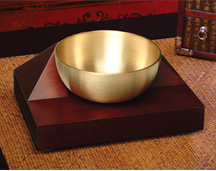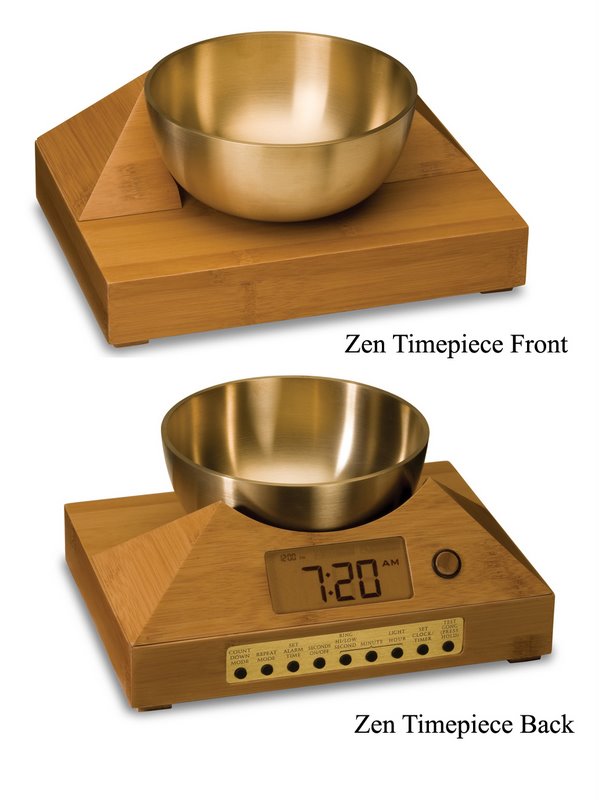
foot massage
The senses can offer a shortcut to rest.
Massage comes to mind. So does aromatherapy; lavender essence in particular, small studies have shown, has a relaxing effect, even reducing stress hormone levels. Visual cues can raise or ease tension, depending on what you’re looking at. It’s a principle of design, for example, that horizontal lines are restful while vertical ones stir up power and tension (think a bed versus prison bars), and cool colors (blue, green) are said to induce more serenity than hot ones (red or orange). Views of nature have helped hospital patients heal faster. Gazing at an aquarium has been shown to slow the pulse.

Carved Wooden Thai Buddha with Singing Bowl
Sound, too, can be a potent relaxant, and tempo is a key player. Using various genres from classical to techno and rap, researchers found that, regardless of what music the subjects liked to listen to, an adagio (such as that from Beethoven’s Ninth Symphony) and an Indian raga physically decelerated the body into a calm state, compared with faster pieces like a Vivaldi presto (L’Estate) or a song by the Red Hot Chili Peppers. One reason for this may be respiratory entrainment, the tendency of the listener’s breath to rise and fall with the music’s beat. But another theory explains that putting on music—of any kind—can recharge you: When the tempo is brisk, it arouses our engagement; then when it slows or pauses, there’s a release of attention that leads to relaxation.
Lhasha Tizer, a wellness coach who teaches sound meditation at the Miraval Resort in Catalina, Arizona, believes that listening to nature’s sounds, a kind of music in itself, may have been the way our earliest ancestors meditated away stress. “Those rhythms create a trancelike state,” she says. (In fact, researchers at the University of Louisville School of Medicine found that a CD of natural sounds—birdsong, ocean surf—markedly shortened the amount of time it took people to physiologically recover from a stressful stimulus when compared with white noise.) “Today, with the way we work and the cacophonic noise we’re exposed to, we don’t have such an automatic gateway to help us focus and settle down,” Tizer points out.
To re-create that trancelike feeling through music, she suggests building up a sound repertoire. Start by being receptive to the sounds around you. Notice how noises affect you—children playing, horns honking, wind blowing through the trees. Gradually begin seeking out simple music with a clear percussive element. Pay attention to the beats you like, identifying the moods they evoke, and use those to guide you in choosing increasingly advanced melodies that carry away your anxiety.
In time, you’ll not only have a database of meditative music but, within it, be able to match your playlist to the mood you want to be in. Ultimately, a good rhythmic rest—and for that matter, any brief escape from a world where you always have to do to a place where you can just be—should make you feel like getting up and dancing.
Our Zen Timepiece’s acoustic 6-inch brass bowl-gong clock is the world’s ultimate alarm clock, practice timer, and “mindfulness bell.” It has the most beautiful natural Singing Bowl Sounds. It is not only an Alarm Clock by a Countdown timer for meditation and yoga.

The Natural Sounds Singing Bowl Alarm Clock from Now & Zen, Inc.
It fills your environment with beautifully complex tones whenever it strikes. In the morning, its exquisite sounds summon your consciousness into awakening with a series of subtle gongs that provide an elegant beginning to your day. Once you experience the Zen Timepiece’s progressive awakening, you’ll never want to wake up any other way. It also serves as the perfect meditation timer. Available in 5 wood styles, including bamboo.
By Sara Reistad-Long
O, The Oprah Magazine
Now & Zen’s Natural Sounds Alarm Clock Shop
1638 Pearl Street
Boulder, CO 80302
(800) 779-6383

Sound Therapy Alarm Clock with Tibetan Singing Bowl
Posted in Natural Awakening, sleep, Sleep Habits